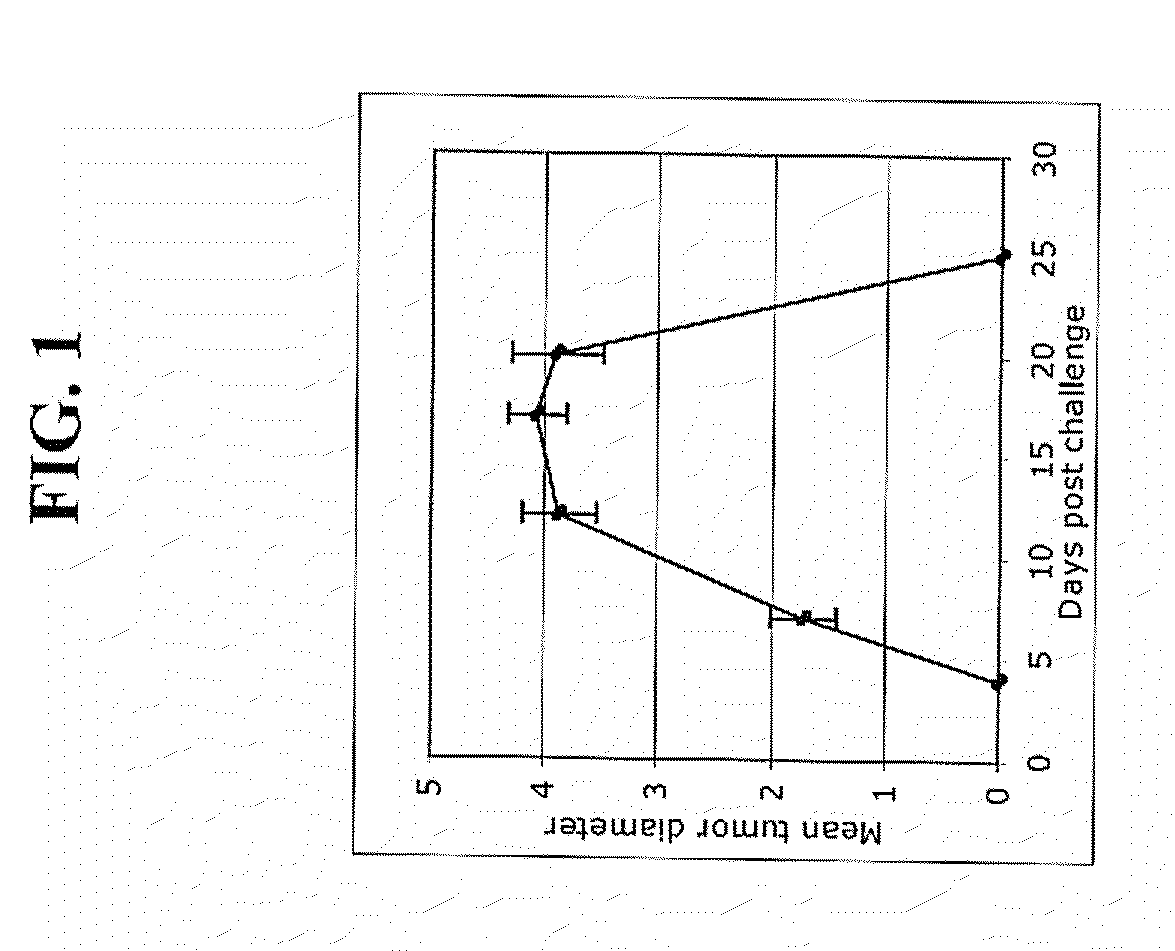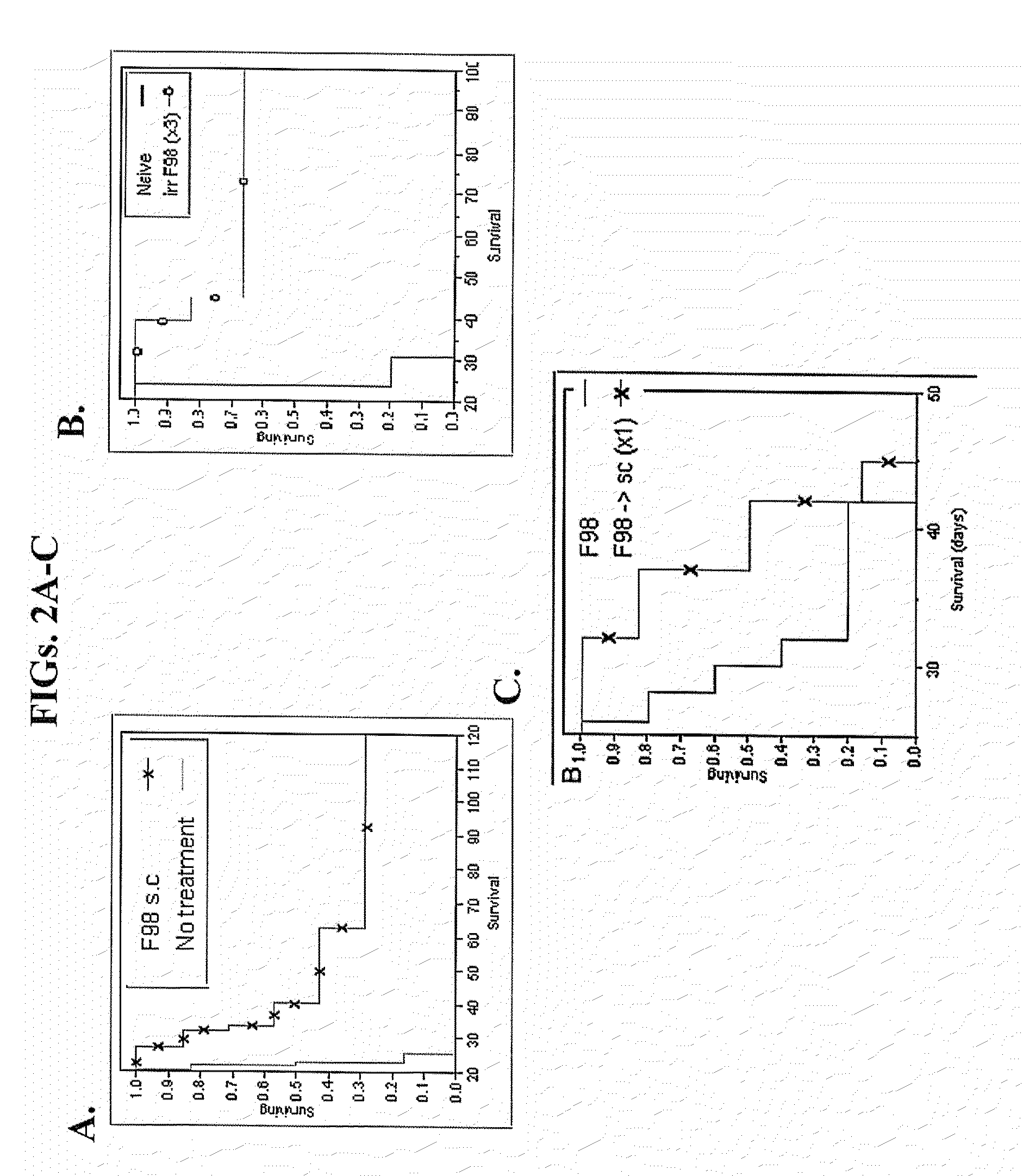Methods of treating tumors in immune-privileged sites
a tumor and immune-privileged technology, applied in the field of tumor treatment in immune-privileged sites, can solve the problems of few new treatments that have achieved widespread clinical success in treating solid tumors, numerous undesired side effects, and none of these conventional methods specifically target only diseased cells, so as to prevent, alleviate or diminish symptoms, and reduce brain tumors.
- Summary
- Abstract
- Description
- Claims
- Application Information
AI Technical Summary
Benefits of technology
Problems solved by technology
Method used
Image
Examples
example 1
Spontaneous Regression of Subcutaneously Injected F98
[0116]The F98 glioma is an anaplastic glioma of Fischer (F344) rat origin with an aggressive biological behavior similar to that of human glioblastoma multiforme. The tumor is a chemically induced tumor and was shown to be refractory to a variety of therapeutic modalities. Its invasive pattern of growth and uniform lethality following an inoculum of as few as 10 tumor cells make it a particularly attractive model to test new therapeutic modalities.
[0117]The following experiment was performed in order to demonstrate the spontaneous rejection of subcutaneously implanted F98 tumor.
[0118]Materials and Methods
[0119]Animals: Fischer F344 rats were obtained from Harlan Israel. Animals were grown in an SPF environment.
[0120]Cells and culture F98 undifferentiated glioma is a chemically induced glioma syngeneic to the Fischer rat. Cells were obtained from the American Type Culture Collection (ATCC) and maintained in DMEM medium supplemented...
example 2
Assessing Protection of Subcutaneously Administered F98 Glioma Tumor Cells on Subsequent i.c. Challenge
[0124]The following experiment was performed to determine whether spontaneous rejection of subcutaneously administered live F98 glioma tumor cells could enhance survival of rats subsequently challenged intracranially with F98 glioma tumor cells.
[0125]Materials and Methods
[0126]Inoculation / immunization s.c.: Rats (6 weeks and older) were shaved at the flank and injected subcutaneously with 50 μl of live (2×105 F98 cells) or 2×106 irradiated tumor cells (5000 rad). For irradiated tumor cells, rats were vaccinated s.c. three times at 14 day intervals with 2×106 5000-rad irradiated F98 cells or were immunized by a single injection of 5000 rad irradiated F98 s.c. (2×106). Tumor size in individual rats was followed by measurement of two perpendicular measurements of the tumors. Rats with tumors above 3.5 cm in mean diameter were euthanized.
[0127]Inoculation of tumors intracranially: Intr...
example 3
Assessing Immunotherapy of Established F98 i.c. by Live F98 Injection s.c.
[0133]The following experiment was performed to assess whether subcutaneous injection of F98 could improve survival of rats with established F98 brain tumors.
[0134]Materials and Methods
[0135]Six-week old female Fischer rats were stereotactically injected with 5×103 F98 tumor intracranially as described hereinabove. Three days following injection rats either received an inoculum of 2×105 F98 glioma s.c. in the flank (cross) or were left untreated (line).
[0136]Results
[0137]As illustrated in FIG. 3, injection of a live F98 tumor s.c. increased survival of rats pre-implanted with the tumor intracerebrally. Survival increased by 167%, although complete loss of tumor was more infrequent in the immunotherapy models than in the protection models.
PUM
| Property | Measurement | Unit |
|---|---|---|
| periods of time | aaaaa | aaaaa |
| time | aaaaa | aaaaa |
| time | aaaaa | aaaaa |
Abstract
Description
Claims
Application Information
 Login to View More
Login to View More - R&D
- Intellectual Property
- Life Sciences
- Materials
- Tech Scout
- Unparalleled Data Quality
- Higher Quality Content
- 60% Fewer Hallucinations
Browse by: Latest US Patents, China's latest patents, Technical Efficacy Thesaurus, Application Domain, Technology Topic, Popular Technical Reports.
© 2025 PatSnap. All rights reserved.Legal|Privacy policy|Modern Slavery Act Transparency Statement|Sitemap|About US| Contact US: help@patsnap.com



